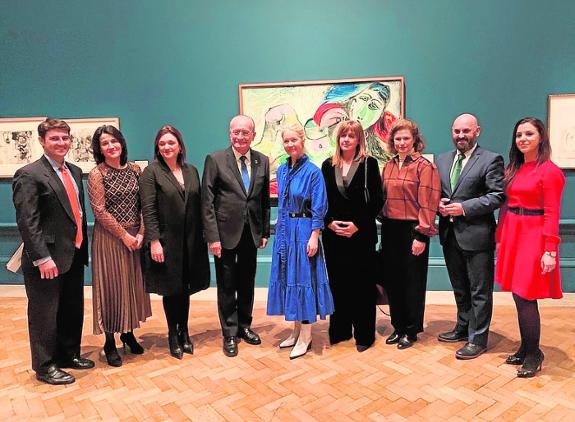London's view of Picasso through paper
The Royal Academy of Arts in London is hosting a major exhibition sponsored by Malaga council, the Diputación, Unicaja Banco and Fundación Unicaja
ÍÑIGO GURRUCHAGA
Martes, 28 de enero 2020, 15:38
The Royal Academy of Arts in London is about to open the most complete exhibition ever to have been organised about Pablo Picasso's use of paper. There are more than 300 works, most of them on loan from the Paris museum dedicated to the Malaga-born artist, and the secretary of the Royal Academy, Axel Rüger, says this is a way of focusing on the prolific imagination of an artist about whom "it would be impossible now to display a complete retrospective".
The structure of the display, whose official presentation was attended by over 700 guests including institutional representatives, cultural agents and directors of major businesses in the UK and Spain, is chronological. Each room reflects a period of Picasso's career, accompanied by one or two important pictures or sculptures to underline the context. Picasso used to keep everything, say the organisers, and that resulted in there being thousands of items, including pages of newspapers upon which he used to draw when he had no other materials to hand.
For his portrait of Josefa Sabastia in Horta de San Juán, in 1898, he used Conté pencil on parchment, which gave it density and definition. When he went to the small village of Gósol in Lérida in 1906, he took Ingres paper and charcoal, watercolours, quill and inks with him and experimented with polyhedral shapes. At that time he was also exploring printing techniques in his Paris studio.
To the experiments in collage which were being carried out by fellow artist Georges Braque, with the shapes of what would be called cubism, Picasso added fragments of card or newspaper. With oils on cardboard, he worked on progressive sketches which would become The Young Ladies of Avignon, where he showed his liking for primitive African art and its colourful vitality.
The exhibition includes a video of a performance of the ballet Parade, an idea by Jean Cocteau to be executed by Serge Diaghilev's Russian Ballet, with music by Erik Satie, to which the Spanish painter contributed the backdrop and costumes. The attire of one of the leading characters, the French director, was made from cardboard.
Between 1914 and 1924, as this display shows, Picasso slid from cubism towards a realism of line, inspired by the work of Ingres, and produced portraits of Stravinski, his first wife, Olga Jojlova and Renoir, in ink, pencil or charcoal. He then embraced surrealism and, when the Civil War began, drew sketches on paper of elements of what would become his Guernica.
In the Second World War he stayed in Paris, with the blinds of his studio closed to protect himself from those who classified his work as degenerative work, paid "an arm and a leg" for sheets of Japanese paper and continued to draw and paint with watercolour and gouache.
The display comes to an end with the documentary The Mystery of Picasso and the rapture of colour and eroticism in his final years. He was, say the organisers of this exhibition, "one of the most important artists of the 20th century". In fact, a few metres from the Royal Academy, the Art & Language collective is showing The Art of Picasso in the Style of Jackson Pollock at the Sprovieri gallery, with a superimposition of his forms and text. Not far away, the Gagosian completes the scene with the fantasy of Salvador Dalí in a hyper-realistic portrait of life in Hollywood.
Promoting tourism
This ambitious display is part of a major tourism and cultural campaign organised by Malaga in London this week in synergy with the prestigious Royal Academy of Arts.
The signing of the agreement was attended by the CEO of Turismo Costa del Sol, Margarita del Cid; the mayor of Malaga, Francisco de la Torre, and the president of the Royal Academy of Arts (RAA), Rebecca Salter, with Cristina Rico on behalf of Fundación Unicaja and Juan de Mata Sanz representing Unicaja Banco.
